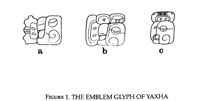The Yaxha emblem glyph as Yax- ha
 Kelley (1976:201) first suggested the a value for the T743 head sign,
based on an entry in Landa’s “alphabet” (Fig. 2a), and its
interchangeability with T238, long recognized as a (2b).
Kelley (1976:201) first suggested the a value for the T743 head sign,
based on an entry in Landa’s “alphabet” (Fig. 2a), and its
interchangeability with T238, long recognized as a (2b).
The first a given by Landa seems to be T743 or a similar head sign
having a blunt, down-curved beak. This has generally been thought to
represent a turtle (aak in Yucatec). Here I will provide reinforcement
of Kelley’s suggestion by noting a number of examples in which T743
replaces other established forms of a.
(1) At Palenque, the sign T743 substitutes for T12 in the name of the ruler “Aac Kan.” The
example using T743 occurs in the text on the edge of the sarcophagus lid in the crypt beneath
the Temple of the Inscriptions (Fig. 2c), while that employing T12
appears in the text of the East Tablet of the temple itself (Fig. 2d).
T12 (and T13 as well) has long been recognized as having the a value
(Knorozov 1955, Sec. 2, 3-10), and the apparent equivalence of T743 in
this glyph would strongly indicate that in this case it, too, has the
value a. As the initial sign of the name glyph, the a possibly stands
for the male agentive ah, as it is known to do in many instances.
(2) Another personal name mentioned at Palenque indicates the
equivalence of T743 and another well-known sign for a. The name glyph
of the ruler “Chaacal III” (“Lord Chaac” in the 1974 dynastic list of
Mathews and Schele) customarily has four component signs. These are (a)
the honorific prefix mah k’ina; (b) a sign standing for a, usually
T229; (c) T528, or CAUAC; and (d) the suffix T178, or -l(a) (Fig. 2e).
One example of this name published by Schele and Mathews (1979) comes
from the fallen stucco text of Temple XVIII. It reveals that the second
and third elements of the compound, the a and the CAUAC; can be
replaced by a conflation of T743 and CAUAC
(Fig. 2f). From this, it seems clear that T743 stands for the more common T229 version of a.
(3) The Bonampak Emblem Glyph identified by Mathews (1980) usually has as its main
sign a conflation of two elements — T743 and a lobed sign which resembles T512, but with a
protruding "bone" as a distinguishing mark. Often T743 is the dominant
sign of the two in such conflations, with the only indication of the
other sign being the bone element in place of the upper beak of the
animal (Fig. 2g). In the version of this same Emblem Glyph which
appears on the lintels of Yaxchilan Structure 12, these two components
are separated (Fig. 2h). Here, the T229 a is the prefix to the complete
version of the second element. T743, then, functions in a manner
similar, if not identical, to T229 in these examples, perhaps as an
initial a- or ha- in the
yet incomplete phonetic reading of the Bonampak Emblem Glyph.
Updated: Jun 12, 2005 - 20:33
Created: May 22, 2005 - 19:07
Download this document in PDF format using the icon. You'll need Adobe Acrobat Reader to view the file. |

File Download
|

